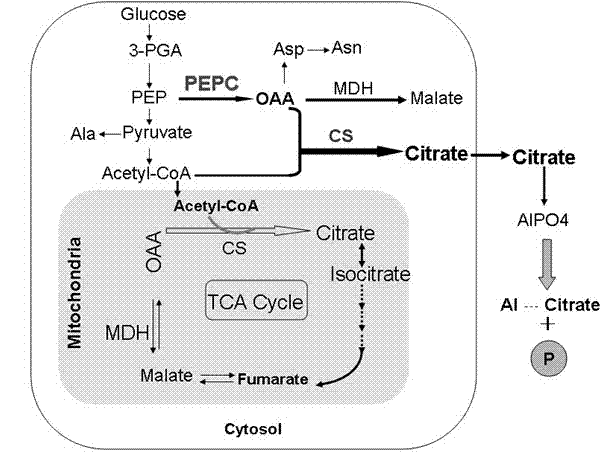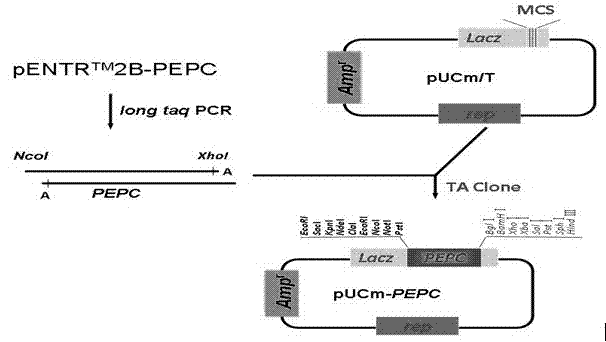Carrier for enhancing aluminum-tolerance of plant, and method for establishing the same
A plant expression vector and vector technology, applied in the field of plant genetic engineering, can solve the problem of carbon source consumption
- Summary
- Abstract
- Description
- Claims
- Application Information
AI Technical Summary
Problems solved by technology
Method used
Image
Examples
Embodiment 1
[0059] Example 1: PEPC Gene amplification and TA cloning:
[0060] PEPC Amplification of gene DNA coding region and TA cloning strategy such as figure 2 As shown, first a pair of primers are designed according to the PEPC gene sequence, the sequence is as follows:
[0061] pepc5:5'-CACC GCATGC CATCAGTCCTCGATGTGACC-3'
[0062] pepc3: 5'- GATATC TTAGCCTGTATTGCGCATCCCCGC-3'
[0063] Add the CACC characteristic sequence to the end of the 5' end primer pepc5, and thus form Nco I restriction site; 3' end primer pepc3 end plus xho I restriction site.
[0064] A thermophilic cyanobacteria mutant PEPC Gene entry vector pENTR TM 2B-KsPEPC (Chen LM. Genetic Engineering of photosynthesis in C3 plant. Yunnan: Yunnan Science and Technology press, 2008) was used as a template, and the mutant was amplified with PEPC-specific primers pepc5 and pepc3 PEPC The DNA fragment of the coding region of the full-length gene (3.0Kb), recovered and purified the PEPC full-length gene f...
Embodiment 2
[0065] Example 2: The construction strategy of the entry cloning vector pENTR*-PrbcS-PEPC:
[0066] PEPC The construction strategy of the gene entry vector pENTR*-PrbcS-PEPC is as follows: Figure 4 As shown, first cut the purified plasmid vectors pENTR*-PrbcS-*T-GFP and pUCm-PEPC with NcoI and XhoI, separate the cut vector and insert fragments by agarose gel electrophoresis, and recover pENTR from the gel The vector fragment pENTR*-PrbcS (4.0kb) and pUCm-PEPC produced by cutting *-PrbcS-*T-GFP PEPC The DNA fragment (3.0kb) of the gene, and then use the ligase kit of TaKaRa to connect pENTR*-PrbcS and PEPC A DNA fragment of the gene generates the entry vector pENTR*-PrbcS-PEPC. Conversion of high efficiencies (10 8 ) Escherichia coli competent cell DH5α, spread the transformed Escherichia coli on the plate added with kanamycin (Km, 50 mg / ml), at 37 o C culture overnight, screen the Km-resistant recombinant colony, extract the plasmid from the Km-resistant recombinant c...
Embodiment 3
[0067] Embodiment 3: Construction strategy of PEPC gene plant expression vector pH2-35S-PrbcS-PEPC:
[0068] The PrbcS-PEPC was subcloned into the plant expression vector pH2GW7 (Gateway's destination vector) by the LR reaction of Gateway technology ( Figure 6 ). The specific method is: use the plasmid extraction kit to purify Gateway’s target vector pH2GW7, add pENTR*-PrbcS-PEPC and pH2GW7 each 150 ng, 1 μl LR Clonase II Enzyme Mix (Invitrogen) to the LR reaction system of Gateway, mix both at 25 o C reacted overnight, and integrated PrbcS-PEPC into pH2GW7 through the action of integrase to obtain the plant expression vector plasmid pH2-35S-PrbcS-PEPC of PEPC ( Figure 6 ). Conversion of high efficiency (10 8 ) Escherichia coli competent cell DH5α, spread the transformed Escherichia coli on the plate added with spectinomycin (Spe, 50 mg / ml), at 37 o C cultured overnight, screened the Spe-resistant recombinant colonies, extracted plasmids from the Spe-resistant recombina...
PUM
 Login to View More
Login to View More Abstract
Description
Claims
Application Information
 Login to View More
Login to View More - R&D
- Intellectual Property
- Life Sciences
- Materials
- Tech Scout
- Unparalleled Data Quality
- Higher Quality Content
- 60% Fewer Hallucinations
Browse by: Latest US Patents, China's latest patents, Technical Efficacy Thesaurus, Application Domain, Technology Topic, Popular Technical Reports.
© 2025 PatSnap. All rights reserved.Legal|Privacy policy|Modern Slavery Act Transparency Statement|Sitemap|About US| Contact US: help@patsnap.com



